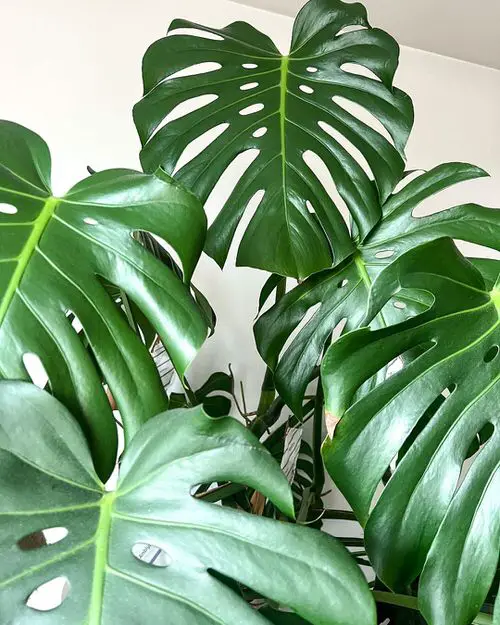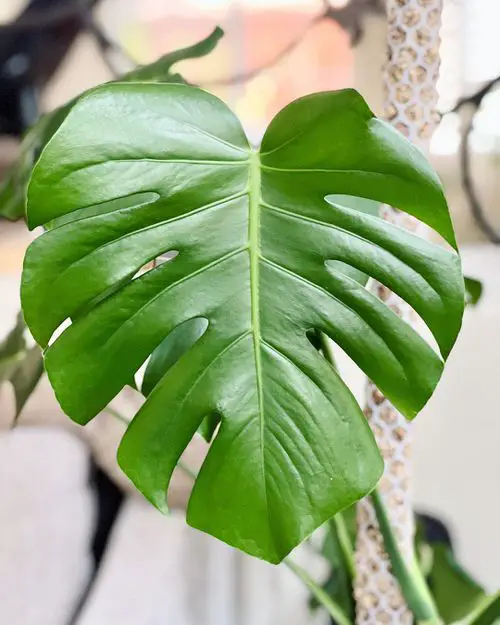Wondering How to Get Split Leaves on Monstera? Here are the reasons and science behind it to get that on your plant with quickly!

If you want dramatic foliage on your plant, then here are 7 incredible tips on How to Get Split Leaves on Monstera. Keep reading!
Check out the secret about growing a lush Monstera here
How to Get Split Leaves on Monstera

#1 Go for a Mature Plant
For fenestration on the foliage, a monstera needs to achieve a certain age. Splitting of the foliage only happens when leaves get to a specific width, mainly 8-14 inches wide, before they get cuts on them.
Younger monsteras don’t have broad foliage, and their leaves are limited to 4-6 inches only.
The best way to ensure you get dramatic foliage from the plant is to get a specimen that’s at least 2-4 years old. If you are fortunate, you will be able to get your hands on a plant that starts to split its leaves from the second year.
Want to grow big and beautiful Monstera? Click here
#2 Propagate the Plant with Old Stem’s Cutting Having Split Leaves
This trick works and is probably the best way to get a plant with cuts on the leaves early–propagate a new monstera plant from an old stem that has one or two large split leaves attached to it. The new plant will have all the parent plant characteristics, which means bigger leaves with cuts and holes!
Choose a cutting with at least 2 leaves having splits and plant it in a well-draining potting mix. Water well, keep it in indirect light, and it’ll grow new leaves in a couple of months, and within 5-6 months after development, you will see the leaves with famous monstera cuts and splits.
Learn how to grow a Monstera in the water here
#3 Make Sure it Gets Light on the Top Leaves
In their native habitat, these plants grow amid other plants with densely packed leaves, which hamper the light from reaching the lower or other foliage parts.
To make sure the light reaches the lower leaves, the plant starts to split its upper leaves.
So, to mimic the same, always keep your monstera in an area where it gets light on the top section more. This will force the plant to split its leaves.
Here are the top Monsteras you can grow
#4 Leaves Split to Minimize the Risks of Bacteria and Fungi
This one can be tricky and may or may not work because it depends a lot on how the plant adapts to its environment, based on how much light and water it is getting.
Monsteras will develop envelopes, cuts, and recesses on the leaves to ensure the water does not stay on the foliage.
So, to get this done, start misting the foliage heavily every day. This will trick the plant into splitting the leaves to get rid of the water to maximize drainage and to keep itself safe from bacteria and fungi that attracts due to wetness.
Note: Do frequent misting only in summers to save the plant from fungal diseases.
Monstera leaves turning yellow? Find the solutions here
#5 Find a Windy Spot

Naturally, a fully developed monstera will split its leaves to let the air pass through because the giant leaves of the plant can act as parachutes, which can block the air, causing disruption. This can make the plant tip over, or the leaves may get ripped off from the plant.
So, to save that from happening, the plant devised a plan to create holes and cuts on its monstrous foliage to let the air pass through. Quite innovative, if you may ask!
The best spot to keep the plant to trick it into splitting the foliage would be a windy balcony, patio, or garden. Just make sure you keep it safe from the harsh afternoon sun. Once the leaves split, you can bring the plant back to its original position.
Have a look at the best-variegated Monsteras here
#6 Provide a Support and Keep it Upright
In their native habitat, the leaves of monstera grow wide as they get the support of the nearby plants or trees while receiving indirect sunlight. This helps them to produce bigger leaves with cuts.
Without the proper support, the weight of the leaves will make the plant drop down, resulting in smaller leaves with no splits.
You can mimic the same by growing it upright and giving it support using stake, pole, support, or trellis. This will result in bigger leaves, making them split faster!
Worried about your Monstera leaves curling? Find the solutions here
#7 Avoid Pruning
As the plant takes its own sweet time to produce bigger leaves and they split after they grow wide (8-12 inches), it’ll be a good idea to avoid pruning the plant every now and then.
This will keep the old and split leaves intact. Also, pruning will trick the plant into growing fresh leaves, which would not have any cuts.



Very informative i truly enjoyed and learn a lot.
I thank you for this!
Everything I read says the splits don’t come until 2 to 3 years. Mine is literally 1 month and 2 days old. My first fenestrated leaf arrived, only 1 split but it’s there!
BUT!
I took a cutting with 1 small leaf and 1 large leaf from a very mature plant. And it only gets light from above, as it’s directly under a window.
Perhaps these are the reasons?
I’m just happy to know this information, thank you!